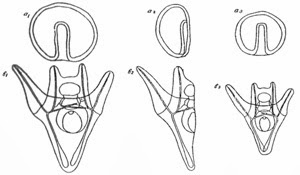The history of cloning of complex organisms has it all...Innovation, competition, turnovers, deceits, love and hate....
And it is so long that for the first time in the history of this blog, I will dedicate two posts to it.
 |
Page from Nicolaas Hartsoeker's book where
he described the homunculus -little child- that
he observed in the sperm. Taken from
Nicolaas Hartsoeker, Essay de dioptrique
Paris: Jean Anisson, 1694, p. 230.
|
For over two centuries, from the 17th till the 20th, a very heated argument over how life is created had been taking place. There were two dominating theories; Preformationism and Epigenesis. Preformationism supported that organisms develop from miniature versions of themselves while the followers of Epigenesis believed that "each embryo or organism is gradually produced from an undifferentiated mass by a series of steps and stages during which new parts are added." (Magner 2002, p. 154)

In 1883, August Weismann, professor of zoology and comparative anatomy at the University of Freiberg and one of the most influencial biologists of his era proposed the first testable model of cell specification, the germ plasm theory. Of all the hypothetical theories on morphogenesis of that era, the germ plasm theory can claim to be at the same time the most logical and the most elaborated and it have had the greatest influence on his peers.
In his theory, Weismann supported that the chromosomes carried the inherited potentials, determinants, of a new organism. However, not all the determinants on the chromosomes were thought to enter every cell of the embryo; the chromosomes of a fertilized egg wouldn't be divided equally in the cells of the embryo but different chromosomal determinants enter different cells. Only the nuclei of those cells destined to become gametes (the germ cells) would retain all types of determinants while the nuclei of all other cells would have only a subset of them. Hence, although the fertilized egg would carry the full complement of determinants, certain somatic cells would retain the “blood-forming” determinants while others would retain the “muscle-forming” determinants, etc.
At the same time his student Wilhelm Roux, who also studied under Ernst Haeckel, proposed a hypothesis that could explain the embryo differentiation by a "mechanistic" process that was similar to Weismann's theory and would later be known as the Roux-Weismann hypothesis of mosaic development.
 In 1888, while working in the Anatomical Institute in Wroclaw -part of Germany at the time-, Roux published a series of experiments that corroborated this theory and became the starting point of experimental embryology. He took 2- and 4- cell frog embryos and destroyed half of the cells of each embryo with a hot needle. If the mosaic development theory was correct then only half embryos would be formed because the remaing cells would only contain the determinants for the characteristics of the cells of that type. Indeed the embryos that survived till the stage of gastrulation produced half-embryos which was a victory for the mosaic theory.
In 1888, while working in the Anatomical Institute in Wroclaw -part of Germany at the time-, Roux published a series of experiments that corroborated this theory and became the starting point of experimental embryology. He took 2- and 4- cell frog embryos and destroyed half of the cells of each embryo with a hot needle. If the mosaic development theory was correct then only half embryos would be formed because the remaing cells would only contain the determinants for the characteristics of the cells of that type. Indeed the embryos that survived till the stage of gastrulation produced half-embryos which was a victory for the mosaic theory.
 In 1888, while working in the Anatomical Institute in Wroclaw -part of Germany at the time-, Roux published a series of experiments that corroborated this theory and became the starting point of experimental embryology. He took 2- and 4- cell frog embryos and destroyed half of the cells of each embryo with a hot needle. If the mosaic development theory was correct then only half embryos would be formed because the remaing cells would only contain the determinants for the characteristics of the cells of that type. Indeed the embryos that survived till the stage of gastrulation produced half-embryos which was a victory for the mosaic theory.
In 1888, while working in the Anatomical Institute in Wroclaw -part of Germany at the time-, Roux published a series of experiments that corroborated this theory and became the starting point of experimental embryology. He took 2- and 4- cell frog embryos and destroyed half of the cells of each embryo with a hot needle. If the mosaic development theory was correct then only half embryos would be formed because the remaing cells would only contain the determinants for the characteristics of the cells of that type. Indeed the embryos that survived till the stage of gastrulation produced half-embryos which was a victory for the mosaic theory.
Three years later Hans Dreisch, another of Haeckel's students, started experimenting with sea urchins trying to confirm Roux's findings while working at the Marine Biological Station in Naples. He chose sea urchins as his animal model because they have large embryo cells, and grow independently of their mothers. Dreich took a 2-cell embryo of a sea urchin and shook it in a beaker full of sea water until the two cells separated. He expected each cell to develop into the corresponding half of the animal to which it has been destined or preprogrammed, but instead found that each developed into a complete sea urchin. This also happened at the 4-cell stage: physiological sea urchins were formed although they were smaller than usual.
 |
a1 and b1: Normal gastrula and normal pluteus. a2 and b2: “Half”—gastrula and “half”—pluteus, that ought to result from one of the two first blastomeres, when isolated, according to the theory of “evolutio”. a3 and b3: The small but whole gastrula and pluteus, that actually do result. Driesch's drawing taken from his Gilfford Lecture.
His experiments contradicted the mosaic theory but also resulted in him abandoning science. Driesch renounced the study of developmental physiology and became a philosophy professor few years later, in 1909, proclaiming vitalism (the doctrine that living things cannot be explained by physical forces alone) until his death in 1941.
|
 In 1897, Hans Spemann started experimenting with salamander embryos at the University of Würzburg in Germany. He had been inspired by Weismann's book The Germ Plasm: A Theory of Heredity which he had read one year earlier while guaranteed in the Alpes trying to recover from Tuberculosis. In 1902, trying to give an answer to the Roux-Driesch dispute he used a revolutionary, but yet rather simple method, to divide embryo cells by constructing a nose with his baby daughter's hair. Spemann tied this loop around the middle of the jelly-like membrane that salamander embryos have and squeezed it so that the two divided cells were formed into opposite halves of the egg's membrane. From these two newly formed cells two identical salamander embryos were developed both of them whole and normal.
In 1897, Hans Spemann started experimenting with salamander embryos at the University of Würzburg in Germany. He had been inspired by Weismann's book The Germ Plasm: A Theory of Heredity which he had read one year earlier while guaranteed in the Alpes trying to recover from Tuberculosis. In 1902, trying to give an answer to the Roux-Driesch dispute he used a revolutionary, but yet rather simple method, to divide embryo cells by constructing a nose with his baby daughter's hair. Spemann tied this loop around the middle of the jelly-like membrane that salamander embryos have and squeezed it so that the two divided cells were formed into opposite halves of the egg's membrane. From these two newly formed cells two identical salamander embryos were developed both of them whole and normal.
Spemann had documented the first in-vitro animal clone!
He continued working with salamander embryos and with Hilde Mangold they published a series of ingenuous experiments in 1924. In one of them they attempted the transfer of the nucleus of a sixteen-cell embryo to a single salamander embryo cell with no nucleus. The cell took up the nucleus and developed into a normal salamander. With this process, Spemann and Mangold completed one of the first cloning experiments using the nuclear transfer method.

Unfortunately, Hilde Mangold died at the same year from a gas heater explosion in her house. She didn't live to see her thesis on the salamander embryos' work get published neither the Nobel Prize that was awarded to her mentor Hans Spemann in 1935 for their revolutionary work.
In 1938 Spemann published a book with his results entitled Embryonic Development and Induction. He wondered whether cells that have already been differentiated would be able to form new organisms and speculated about the possibilty of creating a new organism by transferring the nucleus from a differentiated cell into an enucleated egg. As he explained it: "Decisive information about this question may perhaps be afforded by an experiment which appears, at first sight, to be somewhat fantastical. This experiment might possibly show that even nuclei of differentiated cells can initiate normal development in the egg protoplasms."
......to be continued....
1. August Weismann: The Germ-Plasm: A Theory of Heredity translated by W. N. Parker in 1893
2.Dreisch's Gillford Lecture
3. Dr. Ann A. Kiessling and Scott C. Anderson: Human Embryonic Stem Cells: An Introduction to the Science and Therapeutic Potential
4. Oscar Hertwig: The Biological Problem of Today











